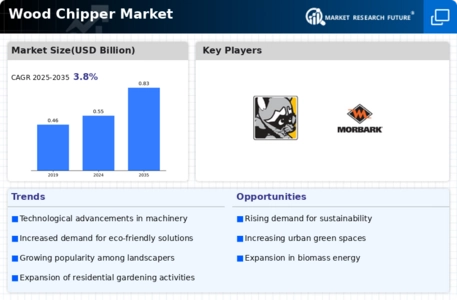Wood Chipper Size
Wood Chipper Market Growth Projections and Opportunities
The wood chipper market is influenced by various factors that shape its dynamics and growth trajectory. One significant market factor is the demand for wood chippers in the forestry and landscaping industries. These industries rely heavily on wood chippers for processing wood waste and debris efficiently. As environmental concerns continue to grow, there's an increasing emphasis on sustainable forestry practices, driving the need for equipment like wood chippers that can aid in waste management and recycling.
Technological advancements also play a crucial role in shaping the wood chipper market. Manufacturers are constantly innovating to develop more efficient, powerful, and user-friendly wood chippers. These advancements may include features such as higher horsepower engines, improved cutting mechanisms, and enhanced safety features. As a result, consumers are often inclined to invest in newer models that offer superior performance and productivity.
Market factors also include regulatory policies and environmental standards. Governments around the world are implementing stricter regulations regarding emissions, noise levels, and safety standards for industrial equipment, including wood chippers. Manufacturers must comply with these regulations to ensure their products meet the necessary criteria for sale and use. Additionally, initiatives promoting sustainable forestry practices may influence market demand for wood chippers that prioritize environmental friendliness.
The overall economic landscape significantly impacts the wood chipper market. Economic factors such as GDP growth, consumer spending, and construction activity influence the demand for wood chippers. During periods of economic expansion, there tends to be higher demand for landscaping services, leading to increased sales of wood chippers. Conversely, economic downturns may lead to reduced spending on landscaping and forestry activities, impacting the market negatively.
Another important market factor is the availability and cost of raw materials. Wood chippers require high-quality materials for manufacturing, including steel for the frame and cutting components. Fluctuations in the prices of raw materials can impact production costs for manufacturers, potentially affecting pricing strategies and profit margins. Moreover, the availability of sustainable wood sources can influence market dynamics, especially as concerns about deforestation and habitat destruction grow.
Consumer preferences and trends also shape the wood chipper market. Some consumers may prioritize features such as portability and ease of maintenance, while others may focus on power and efficiency. Additionally, there's a growing trend towards electric and hybrid wood chippers as environmental awareness increases and technology improves. Manufacturers must stay attuned to these preferences and adapt their product offerings accordingly to remain competitive in the market.
Competition within the industry is another significant market factor. With numerous manufacturers and brands vying for market share, competition can drive innovation and product development. Companies may differentiate themselves through product quality, pricing strategies, customer service, and marketing efforts. As a result, consumers have a wide range of options to choose from, leading to a dynamic and competitive market environment.
Finally, demographic factors such as population growth and urbanization also influence the wood chipper market. As populations expand and urban areas develop, there's an increased demand for landscaping services and equipment, including wood chippers. Urbanization also leads to the generation of green waste, such as tree trimmings and branches, further driving the need for wood chippers in residential and commercial settings.



 Source: Secondary Research, Primary Research, Market Research Future Database and Analyst Review
Source: Secondary Research, Primary Research, Market Research Future Database and Analyst Review


Leave a Comment